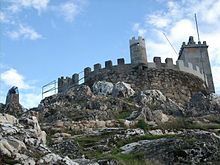Folgosinho
| Folgosinho | ||||||
|---|---|---|---|---|---|---|
|
||||||
| Basic data | ||||||
| Region : | Centro | |||||
| Sub-region : | Beiras e Serra da Estrela | |||||
| District : | Guarda | |||||
| Concelho : | Gouveia | |||||
| Coordinates : | 40 ° 31 ′ N , 7 ° 31 ′ W | |||||
| Residents: | 499 (as of June 30, 2011) | |||||
| Surface: | 51.69 km² (as of January 1, 2010) | |||||
| Population density : | 9.7 inhabitants per km² | |||||
| politics | ||||||
| Mayor : | Fernando Manuel Carmo Henriques | |||||
| Address of the municipal administration: | Junta de Freguesia de Folgosinho Rua Dr. Vasconcelos 6290-081 Folgosinho |
|||||
| Website: | www.followosinho.com | |||||
Folgosinho is a municipality ( freguesia ) in the Portuguese district of Gouveia . It has 499 inhabitants (as of June 30, 2011).
geography
It is located at an altitude of 933 meters, in the middle of the Serra da Estrela , the highest mountain in continental Portugal. Folgosinho is 11 km from the district town of Gouveia and 45 km from the district capital Guarda .
history
Presumably between two Celtiberian castros (dt .: Wall castles ), the place received city rights ( Foral ) for the first time in 1187 , by King Sancho I. As part of the defense lines first against the Moors and then against the Castilians , the place was important for a long time. After the Reconquista and the consolidation of the Kingdom of Portugal , Folgosinho gradually lost his position.
In 1512 King Manuel I renewed the town charter . Until 1836 Folgosinho was the seat of an independent district ( concelho ), and since then it has belonged to the Gouveia district. The extensive isolation of the place was alleviated in 1914 when the national road was built that connected the place to the municipality of Nabais and the regional road network. The congregation gained nationwide fame from 2006 through the film Ainda Há Pastores? that was filmed in the municipality.
Culture, sports and sights
Among the 14 listed buildings, in addition to various churches, fountains and mills, the castle from the 12th century and the historic town center should be mentioned. There is also a monument to the Lusitanian leader Viriathus (port. Viriato).
Hiking trails run through the surrounding area, which lies in the wider area of the Serra da Estrela nature park and the source of the Mondegos and is characterized by mixed forest and watercourses. In particular, the Rota dos Galhardos (PR 1) hiking trail belonging to the smaller routes (Pequena Rota, PR) should be mentioned here, which is based on two Roman footpaths running here . Larger routes (Grande Rota, GR) cross the PR 1, such as the GR 22 of the Inatel , a hiking trail along the historic villages .
Various sports clubs, folk dance groups, the Folgosinho Volunteer Fire Brigade and an association of hunters and anglers are active in the municipality . The local handicrafts offer u. a. traditional woolen capes, hats and vests of shepherds. The local cheeses are also known.
administration
Folgosinho is the seat of a municipality of the same name. The neighboring municipalities are (starting clockwise in the north): Melo , Vila Cortês da Serra , Freixo da Serra , Figueiró da Serra , Linhares , Videmonte , Vale de Amoreira , Famalicão , Valhelhas , Sameiro , Manteigas , Gouveia , São Paio and Nabais . There are a number of estates and towns in the municipality, including:
- Barrocal
- Casais de Folgosinho
- Casal do Mondego
- Casal de S. Pedro
- Casal da Feiteira
- Covão da Ponte
- Covão de Santa Maria
- Portela de Folgosinho
- Quinta do Mondego de Baixo.
economy
In the Serra da Estrela region, which is already structurally weak , Folgosinho is remote from the region's few economically dynamic centers. Emigration therefore characterizes the demographic development of the place even more than is already the case in the region. At the same time, the community can show an almost intact environment.
In addition to social and public institutions, there are bank branches, various retail and catering businesses. In addition to agriculture (grain, cattle farming, forestry, honey), tourism has gained in importance, not least because of the publicity of the film Ainda Há Pastores? (German: Are there still shepherds?) by the director Jorge Pelicano 2006. Here the rural tourism deserves special mention, which attracts friends of nature-based hiking and recreational vacations.
Web links
- Official website
- Folgosinho website on the Gouveia County website
- Information gathered on Folgosinho, on the website of the Jornal A Guarda newspaper
Individual evidence
- ↑ a b www.ine.pt - indicator resident population by place of residence and sex; Decennial in the database of the Instituto Nacional de Estatística
- ↑ Overview of code assignments from Freguesias on epp.eurostat.ec.europa.eu
- ↑ www.cm-gouveia.pt , accessed on November 12, 2012
- ↑ www.folgosinho.com , accessed on November 12, 2012
- ↑ www.monumentos.pt , accessed on November 12, 2012
- ↑ ditto
- ↑ ditto





